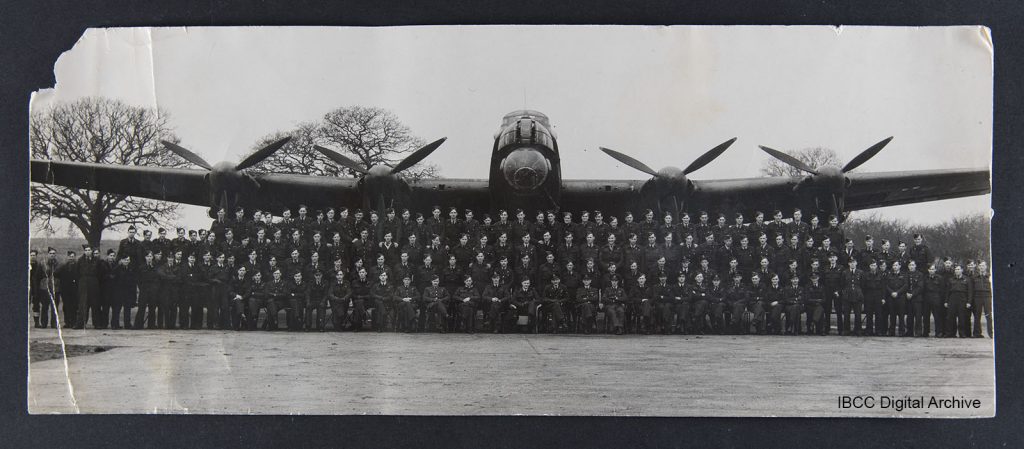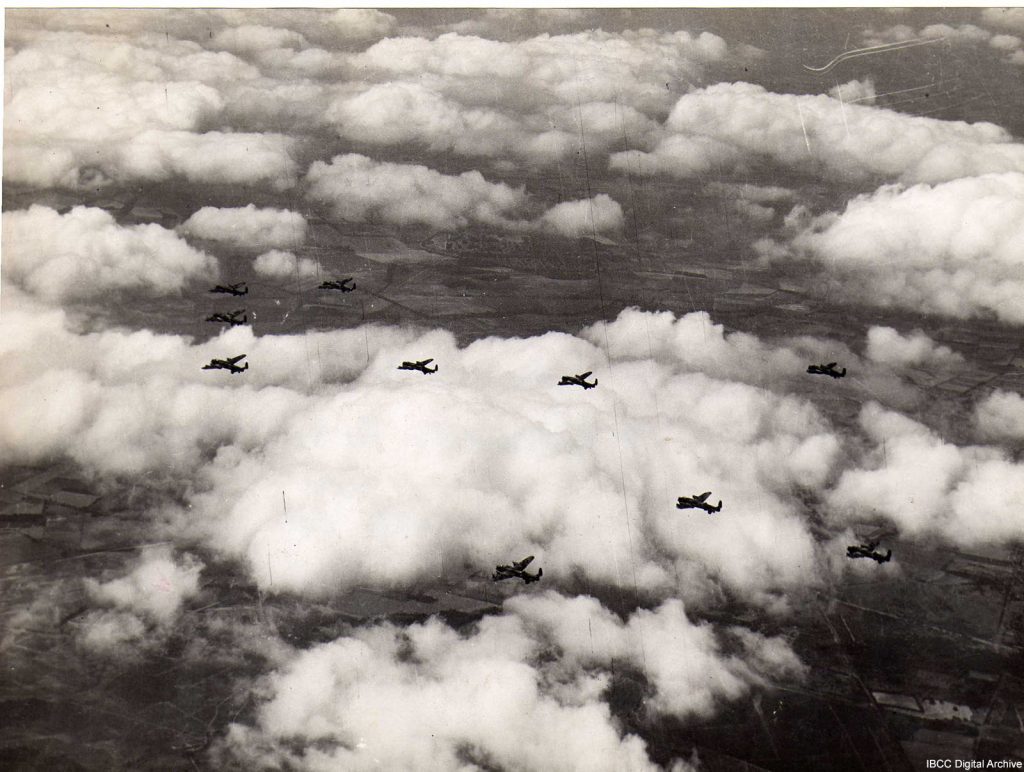I watched this documentary film half expecting to see 100 minutes of Lancaster porn. However, to the disappointment of some viewers, this is not a film about the Lancaster. It is not even a documentary about Bomber Command – this is effectively a documentary about Bomber Command veterans and the public memory of the bombing war.
The documentary is high quality and well-crafted; it is beautifully researched and makes good use of classic and archive films, still photographs, news report audio, voice over and veteran ‘talking heads’. The veterans’ individual stories glue the whole thing together and the quotes were skilfully used to tell the bigger story. The filming of the Battle of Britain Memorial Flight’s Lancaster is emotive and unusual in that several air-to-air shots were taken towards dusk. While the film does not directly address that the Lancaster was designed as a killing machine it does attempt to engage with the technical, military, strategic, moral and political complexities of the heritage of RAF Bomber Command and the roles the Lancaster, the veterans, and the Command played in the war.
It goes to some length to explain the context behind the aircraft’s design and use. It does a good job of describing crewing up and the different roles for each aircrew position, it discusses the changes of strategy around D-Day, considers the technical advances in radar and countermeasures and the difference between area and precision bombing. The film well describes the Hamburg, Peenemunde, Nuremberg operations, ‘Happy Valley’ and the ‘Battle of Berlin’. For many people, the cultural memory of Bomber Command is either the Dam Busters (Operation Chastise to breach the Ruhr dams) or Dresden. The film considers both.[1] In this documentary, the section on 617 Squadron’s attack on the Ruhr dams was slightly too long, even though this is the operation that underpins the Lancaster legend. However, probably because of their interviews with Johnny Johnson, the last remaining ‘Dam Buster’, it focussed on the usually under-told story of the Sorpe. In the section on Dresden, one veteran indicated that the Russians requested the attack as the city was a legitimate military target as a transport hub, but perhaps unhelpfully, the bombing was illustrated by animated archive film of Meissen porcelain figurines waltzing.

Squadron personnel in front of Lancaster https://ibccdigitalarchive.lincoln.ac.uk/omeka/items/show/17107
If you are familiar with the history of the strategic bombing campaigns during the Second World War, the film ticks all the boxes you would expect, but it also repeats the tropes and clichés we’ve been hearing over the last decades. Fighter Command and the Spitfire ‘saved the country in its hour of need’, but the Lancaster was ‘the aircraft that would help Churchill win the war’. The film repeats Arthur Harris’s famous ‘they started it’ speech and highlights that 43,000 people were killed in the London Blitz.
With interviews with Neil Flanigan, a Jamaican ‘erk’, WAAF veterans, Elizabeth Mortimer-Cook, Betty Tring and Wendy Carter, and Ursula Dickinson, a German witness, the film is inclusive, however there was no mention of class difference within the RAF, and they could have done more to tell the story from both sides. For a documentary that relies so heavily on oral testimonies, it fails to address some of the issues about using these sources. The veteran testimonies are unquestioningly accepted, but as Bomber Command veteran and historian Noble Frankland admitted, eyewitnesses tend to be unreliable.[2] As in some of the IBCC Digital Archive’s interviews, the veterans retell well-rehearsed ‘crystallised narratives’ and frequently say with confidence things they could only have learned after the war. In the film, Peter Kelsey, Ernie Holmes, and Bill Gould describe their disquiet with what they had been asked to do, but Johnny Johnson opens the film on the defensive with a comment about ‘retrospective historians’. Reinforcing the ‘powerful memory narrative of veterans as victims of neglect,’[3] almost all the veteran testimonies fit into a heroic victim framework. They discuss desperate corkscrew maneuvers away from night fighters, the ‘chop’ and ‘empty chairs at empty tables’. Although New Zealand veteran, Ron Mayhill said that the unveiling of the Bomber Command memorial in London in 2012 changed things, Jo Lancaster, John Bell, and Jack Watson talked about the lack of recognition for Bomber Command, and Rusty Waughman reiterates that Harris ‘carried the can’ for Churchill and politicians after Dresden.
Directorial choices including the use of pyrotechnics and the musical score subtly amplify these narratives and continue to reinforce the way Bomber Command has been remembered. Fireworks are used as a metaphor for Flak, but not for the falling target indicators from the perspective of those on the ground. The emotive air-to-air shots of the solitary Lancaster approaching the coast at dusk appears after comments ‘defences unbelievable’ and ‘suicide’. On its own and at low altitude, it appears vulnerable, and the documentary fails to convey the size and power of Bomber Command towards the end of the war when over 1000 aircraft could be operational every night.
The Lancaster continues to be a symbol for Bomber Command and its veterans, and this documentary is very much a product of today. Like John Nichol’s recent book Lancaster: The forging of a very British Legend, the focus of this documentary is on the memories of the few remaining aircrew rather than the aircraft. It is a must watch for the new footage of the Lancaster in flight and for the clips of the veterans, but to be able to access the unedited interviews recorded for the film would be incredible.
Dan Ellin & Nigel Moore
[1] Ellin, D and Lawrence, C (2018) ‘After Them, The Flood: Remembering the Dam Busters and Bomber Command through Performance’. In: Staging Loss Performance as Commemoration. Palgrave Macmillan, pp. 109-129.
[2] Frankland, N History at War: The campaigns of an historian, Giles de la Mare, London, 1998, p.34
[3] Hughes, H ‘Memorializing RAF Bomber Command in the United Kingdom’ Journal of War & Culture Studies 2021, p.10.
IBCC Digital Archive interviews with veterans included or credited in the film:
Benny Goodman https://ibccdigitalarchive.lincoln.ac.uk/omeka/collections/show/514
Bill Gould https://ibccdigitalarchive.lincoln.ac.uk/omeka/items/show/10832
Bob Leedham https://ibccdigitalarchive.lincoln.ac.uk/omeka/items/show/11304
Cecil Chandler https://ibccdigitalarchive.lincoln.ac.uk/omeka/items/show/10736
Charles Clark https://ibccdigitalarchive.lincoln.ac.uk/omeka/collections/show/229
Daphne Brownlie https://ibccdigitalarchive.lincoln.ac.uk/omeka/items/show/8364
David Fraser https://ibccdigitalarchive.lincoln.ac.uk/omeka/items/show/5527
Ernie Holmes https://ibccdigitalarchive.lincoln.ac.uk/omeka/items/show/11118
George Dunn https://ibccdigitalarchive.lincoln.ac.uk/omeka/collections/show/510
Gerry Norwood https://ibccdigitalarchive.lincoln.ac.uk/omeka/items/show/11429
Hal Gardner https://ibccdigitalarchive.lincoln.ac.uk/omeka/items/show/10823
Harry Hodgson https://ibccdigitalarchive.lincoln.ac.uk/omeka/items/show/11113
Jack Watson https://ibccdigitalarchive.lincoln.ac.uk/omeka/items/show/11760
Jan Black https://ibccdigitalarchive.lincoln.ac.uk/omeka/collections/show/333
Jo Lancaster https://ibccdigitalarchive.lincoln.ac.uk/omeka/collections/show/551
Johnny Johnson https://ibccdigitalarchive.lincoln.ac.uk/omeka/collections/show/252
Ken Johnson https://ibccdigitalarchive.lincoln.ac.uk/omeka/collections/show/546
Len Manning https://ibccdigitalarchive.lincoln.ac.uk/omeka/items/show/3448
Ron Mayhill https://ibccdigitalarchive.lincoln.ac.uk/omeka/items/show/17900
Rusty Waughman https://ibccdigitalarchive.lincoln.ac.uk/omeka/collections/show/348
Tom Rogers https://ibccdigitalarchive.lincoln.ac.uk/omeka/items/show/10331



